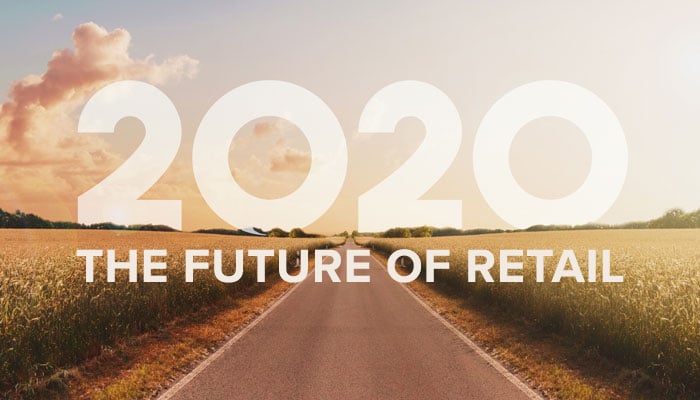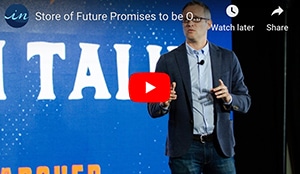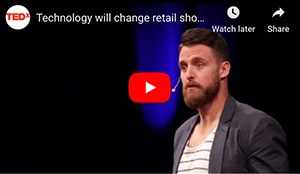The Future of Retail: Predictions, Advice, Trends
The future of retail is a hot topic of conversation. New research emerges daily, stories are written, and boardroom-bound executives gnash their teeth over what exactly that future is going to look like. While no one knows for sure what the future holds, there are emerging trends and technologies that provide clues and can’t be ignored. This report assembles insights from some of the brightest and most innovative thinkers in retail to illuminate which “future of retail” trends are on the way to becoming the status quo.

Get a comprehensive look at the best current thinking on the future of retail. Learn what’s being said by industry leaders, top retailers, technologists, and futurists in search of a consensus on where retail is headed in 2020, 2030 and beyond. Topics include:
- The size and overall health of the retail industry
- How to handle market challenges
- The transformation of brick and mortar stores
- How technology is changing retail
- The future of retail and data
- Key retail predictions for 2020
- Future of retail predictions for 2030
You’ll find answers to pressing questions such as:
- Is the retail industry growing?
- What are the challenges retailers face?
- Will physical stores disappear?
- What can companies do to compete in the changing retail environment?
Future of Retail Video
This video is a great place to start learning about the future of retail. It provides a survey of where leading minds in retail such as Rachel Schechtman, Kilian Wagner, Chris Walton, Angela Wang, and Doug Stephens. The article also includes insights from retail influencers like Devora Rogers and Steve Dennis.
How big is the retail industry?
Despite healthy sales traditional brick and mortar retailers continue to close stores and consolidate their physical footprints. Almost 4,000 stores closed in 2018 (Toys R’Us and Walgreens saw the largest number of closures), and thousands more are expected to shutter in 2019. How can retail be healthy and contracting at the same time? The answer: Ecommerce.
Per DigitalCommerce360.com, “Early analysis from Internet Retailer show online retail sales in the U.S. crossed $517 billion in 2018, a 15.0% jump compared with 2017. The growth in retail sales in physical stores reached 3.7% last year. This means that ecommerce now accounts for 14.3% of total retail sales when factoring out the sale of items not normally purchased online. And it also means that in only a decade, the web has more than doubled its share of retail sales. Ten short years ago, ecommerce was at 5.1% of total retail purchases.”
Is the retail industry growing?
Retail is unequivocally growing, but by how much and where? That’s a little more complicated. According to the National Retail Federation’s State of Retail report, both brick and mortar and ecommerce sales are on the rise, with ecommerce growing at a far more rapid clip.
Ecommerce is formally defined as the exchange of goods or services for money through an online or electronic network. Ecommerce is less formally defined as “shopping online” or “buying stuff with my phone.” While growth in traditional retail is slow — low single-digits per year at best — growth in ecommerce is exploding.
According to online publication The Balance, total retail sales “hit a record of $6 trillion in 2018, according to the U.S. Census. That’s better than the pre-recession high of $4.4 trillion spent in 2007. It’s also a 50% increase from 2009’s record low of $4.06 trillion.” (Note: Yes, this number is larger than the one listed above from Internet Retailer. Different organizations have different methodologies for determining the overall size of retail, and we’re including a few of them to better present the potential range of retail spending.)
NRF’s State of Retail report also contained these nuggets:
- Since 2010, retail sales have grown nearly four percent each year
- In 2018, for every store that closed, two opened
- Beauty and home improvement are showing the most growth
“People associate with retail brands, and when one closes, it makes news,” says Mark Matthews, Vice President, Research Development and Industry Analysis, for the National Retail Federation (NRF). In this accounting, media trends are perpetuating the notion of struggling retail when the opposite is often true. But that doesn’t mean it’s all bad press and retailers will have an easy time in the coming decade. Far from it.
What are the challenges retailers face?
For the first time, shoppers have gained control over retailers, who now face the challenge of managing consumers’ high and ever-changing expectations. Online and brick and mortar stores need to provide a unique experience for customers that offers convenience, speed, value, and personalization.
“Without a doubt, retail is going shopper-centric,” says Ray Hartjen, Marketing Director, RetailNext. Just a decade ago, retailers decided which products to carry and how to price them. Selections were limited, and online shopping was far from easy or convenient. Many people did not believe ecommerce would ever deliver a safe, fast and convenient shopping experience.
Widespread broadband and improved online experiences and security changed everything. “Shoppers are now dictating to retailers. You have to understand me; you have to get me, and you have to make it easy for me,” Hartjen shares. “It is an exciting time for shoppers because they are in control and it is never going back. Retailers need to catch up to the shoppers.”
“Most Americans seem to be busier than ever, so people are looking for solutions that make their lives easier,” explains trends expert Daniel Levine.
Sometimes, catering to customer desires isn’t cost-effective for retailers, especially those who operate online. “It is easy to establish a brand online, but you don’t make any money online. Price margins are relatively low,” Hartjen says. “Consumers have come to expect things like free shipping and returns, so it makes the old paradigm of gross sales almost irrelevant. We order more than what we are going to buy and keep.”
Hartjen adds that customers return the items they don’t want. Often, when the retailer receives the merchandise, it’s out of season or not in a sellable condition. “Now you’re seeing more and more brands look at profitable sales [not just gross sales].”
Also, customers are more particular about the companies they’ll support with their shopping dollars, and they want to know:
- Is the company inclusive of different kinds of people?
- Do their products promote health and wellness?
- Are retailers protecting the environment?
- Are the products created from sustainable materials?
- Do they treat their workers well and pay them a fair wage and provide good working conditions?
Levine says this phenomenon is changing and mostly involves Generation Z and younger, but includes Millennials. “Generationally, there is a difference,” he says. “Younger people want to leave the world better than they found it.” Levine says price is still the number one factor driving purchase decisions, and sensibilities decline in importance as the difference in price increases.
So-called “culture clubs” also say a lot about a brand. A company’s internal culture and how they help their people grow and prosper speaks volumes, and consumers are taking note. The retail industry has long been synonymous with low pay and high turnover, and customers notice when employees are unhappy. Modern retailers are paying more attention to the workplace environment and prioritize taking care of their staff. If they’re happy, they are more likely to give customers the personalized attention they crave, helping them to build better relationships with the brand.
There is also another factor in play when people choose where to spend their money. “I think it’s a question of privilege. It’s really easy to say [you won’t shop somewhere] if you have the financial ability to shop somewhere else,” says futurist and keynote speaker Anat Baron.
Will physical stores disappear?
Disappear? On the contrary: Physical stores are making a comeback. The National Retail Federation’s State of Retail report shows about half as many stores closed in 2018 as in the prior year, as retailers continue to adapt to the new shopper.
“I don’t think brick and mortar are going away, but we haven’t figured out what the next big thing is for brick and mortar,” Levine explains, pointing to the number of empty storefronts, both small and big box. “Something will happen.”
Ok, so something will happen, but what? Retailers need to find their own “right” solution. For many, it starts with updating outdated technology and infrastructure and closing stores. RetailNext’s Hartjen suggests many companies have too many stores which are physically too big. “Retail is growing, and the brands that are going to succeed are the ones that are making it easy for the shopper to get what they want, when they want, and how they want,” he says.
Hartjen uses the example of the transformation in mattress shopping. Customers went to large showrooms to try out a huge inventory of mattresses. Comparison shopping proved difficult for customers because brands and styles varied by store. Once a customer made a purchase, the store would deliver a mattress and box spring. Now, people buy beds online that arrive at their homes in a smaller-than-you’d-expect box.
Brick and mortar locations are updating fast
Physical stores aren’t going away, but they are changing. Target is now operating a variety of store formats, including the gigantic “Super Target” big box common in suburban locations and the newer small-footprint configurations opening up in densely populated urban areas. Nordstrom has its traditional department stores, plus Nordstrom Rack for a limited selection of inventory at lower prices, and Nordstrom Local, which has no physical inventory for sale at all. Instead, Nordstrom Local customers try on samples and place an order in store, and the sales staff ships the items to the customer’s home.
Having multiple store formats that appeal to different areas is great, but it isn’t enough. Today’s consumers are looking for a multi-platform (aka “omnichannel”) retail experience assisted and guided by technology. They want to begin their product search on a mobile phone or website, but are willing to continue it in a physical store. Savvy stores recognize this trend and are trying to get ahead of it. As an example, stores are trying out geolocation schemes that use dedicated store apps to welcome customers into a brick and mortar location and offer help finding the items they were looking at online.
Some retailers are incorporating technology like interactive dressing rooms, where people can ask for different sizes and colors of physical items and try things on virtually. Augmented Reality and Virtual Reality can help people see how things look in a variety of colors, sizes, and styles, and help them determine whether items will fit into their homes. For example, Macy’s is using Virtual Reality paired with a 3D Room Planner to let customers design a digital facsimile of their own living room, fill it with Macy’s furniture and home goods, and then walk around the room in VR to check the fit and match of the items. Makeup retailer Sephora is using Augmented Reality-enabled mirrors to show shoppers how different shades will look on a customer’s skin.
Self-checkouts and click and collect stations are also appearing in more physical stores. Some retailers now “employ” robots to search inventory, restock shelves, and even guide customers around the store and offer sales support. Thus far, the robots seem eager to help and are disinterested in science fiction-style world conquest. But the technology is still young.
In addition to investing in technology, some smaller boutique retailers are gaining popularity by catering to shoppers who want to socialize while they browse, and are looking to compare unique or hard to find items in a comfortable setting. These retailers can operate at relatively low overhead, and curate items that will appeal to particular niche shoppers. Stores in tourist areas, or those that carry rare or specialty items like imported foods or artwork, are thriving.
Anat Baron says that customer service is also making a comeback, and predicts that good old fashioned person to person assistance will continue far into the future. Being there for a customer in their moment of need is imperative. “People are shopping where they are having an experience, and someone is making them feel special,” she says.
The future of retail and data
Smart retailers try to get to know their customers better than their customers know themselves, anticipating their wants and needs. Data is key to meeting that objective.
Smartphone also provides valuable data about shoppers. Retailers can get all kinds of information such as GPS data, social media likes, searches, purchases, page views, and more. Consumers expect retailers use the data to cultivate personalization. Special offers, events, etc., are ways to make use of the data you collect.
“Shoppers are willing to connect with you if you provide them value,” Hartjen says. He mentions Sephora’s loyalty program, where members can exchange points for rewards, is especially good at providing value to a customer in exchange for their data.
Retailers need to safeguard the data they collect and use it wisely. For example, customers who add items to a cart online, but don’t make a purchase often receive a follow-up email enticing a shopper to make a purchase. Retailers shouldn’t abuse the knowledge they have about customers.
And having a reliable data security solution in place is essential.
“I think most people will be willing to give up some privacy to have a better [shopping] experience,” Baron says. “Things that were not acceptable 10 years ago are acceptable now.”
“It’s time to marry science with art,” Hartjen says. Retailers can test an item or a concept before expanding it to all of their stores. They can also test what works and doesn’t work online. “The buy button [on a company’s web site] is the color it is because it was tested.”
Devora Rogers – The Science of Shopping & The Future of Retail
“If we can apply some of the data we’ve taken from (code) and some of the learnings that we’re starting to understand about shopper behavior across thousands and thousands of shoppers maybe we can create this sort of new golden era of retail, maybe we can lay bare the walls of the retail store, tear those down, log the data that’s floating around us in the air… if we can do this we can move as marketers from a place of manipulation … to a relationship that’s more about listening. I don’t have to guess what your needs are, I can simply listen to what you’re doing and respond in kind. And that, my friends, is the future of retail.”
The rise of mobile and other technology in retail shopping
Technology is rapidly changing retail and mobile is beginning to take center stage. Mobile stores have improved to the point where you can buy something with just a few touches. NRF’s Matthews often uses mobile apps that show a store’s layout and placement of merchandise to make his shopping easier.
Many retailers are moving from online to offline — the so-called “clicks to bricks” movement. Giants Amazon and Google are building brick and mortar stores. Smaller brands that gained popularity online are doing the same. Examples include eyeglass retailer Warby Parker, shoe retailer Allbirds, mattress seller Casper, clothing retailer Everlane, cashmere’s Naadam, accessory and clothing seller Cuyana, activewear maker Outdoor Voices, and others.
In today’s world of online shopping, subscription services, and voice shopping from smart speakers like Alexa and Google Home, chore shopping is becoming easier. With a click and a credit card, we can order almost anything we need, and it arrives at our door, sometimes within hours. Finding yourself using the last roll of toilet paper isn’t a crisis anymore since you can click, pay, and wait for it to arrive on your doorstep.
QR codes are also making a comeback. Apple’s iOS now includes QR readers in the native camera, so users don’t have to open a separate app. Samsung includes the feature in its internet browser. Third-party code scanner apps are also available.
Mobile technology is also changing loyalty. There was a time when customers were loyal to a store or a brand, and it was the only place they shopped. Now, if one store doesn’t have a product or a customer is looking for another size or color, a quick mobile search can locate that product.
“Loyalty is more about, I will go to you first, and if you don’t have what I am looking for, I will move on,” Matthews explains.
Many people are now shopping inside messaging apps like What’sApp and Facebook Messenger. Some stores communicate about orders and shipping information using chatbots within messaging apps. Customers of Victoria’s Secret, H&M, Pizza Hut, and other companies don’t even need to leave a conversation with a chatbot to make a purchase.
AR is also changing retail. Apple’s AR Kit and Google’s AR Core help retailers to make mobile-ready apps that combine entertainment with retail, hopefully driving sales.
Nike’s SNKRS app uses AR and geolocation to introduce new products to kicks fans and provide purchasing details. For a 2017 product launch, potential customers had to take a photo of a particular restaurant’s menu to have the ability to purchase a coveted pair of shoes.
Now, instead of shopping for something online or visiting a shop consumers can use a magic point of sale. Customers point their device at an object and see information about how and where to purchase the item. The key to success is being there when and how your customers want you to be there.
But it’s not all about small items like shoes. AR is changing how we buy big items like furniture. IKEA’s Place app was one of the first that allowed customers to place virtual objects into real environments. Other retailers are providing a similar feature, and the technology is only improving. Bob’s Discount Furniture, American Furniture Warehouse, Jerome’s Furniture and more are all using some combination of mobile AR, online room designers and Virtual Reality to sell furniture. Macy’s See Your Space IRL initiative allows shoppers to lay out a digital facsimile of their real world space using a 3D Room Planner app, then walk around in the room and check out potential furniture purchases in Virtual Reality. Macy’s also offers in-app Augmented Reality for shopping at home.
What can companies do to compete in the changing retail environment?
Baron predicts customer service is going to be a key to successful retail business, especially for bigger ticket items. Having knowledgeable sales staff available to answer questions for customers is imperative. A sales associate should also be able to help those same customers find additional information including price matching.
“Everyone has a different set of circumstances, so there is no one-size-fits-all advice,” Matthews says. “If you are keeping your customer happy and giving them a good experience, both in-store and online, you’ll do fine.”
Some ways you can prepare for the future of retail:
- Find out where your customers spend their time. These places might become magic points of sale.
- Use your social media channels to tell stories of your products and engage with fans. It isn’t enough to post pictures anymore.
- Pick a focus where you want to improve. Either focus on automation, speed, price, and convenience or human creativity, relationships, and expertise.
- Discover your customers’ pain points like lack of help, parking issues, or long checkout lines and try to relieve them.
“Customers are not differentiating between online and brick and mortar, to them, it’s shopping,” Hartjen says. He points out that they expect the same brand experience regardless if they are browsing items online or in a physical store. “It’s the brand that wins.”
Traditional online retailers are looking at physical stores as a way to win the search game. Hartjen notes winning at online search is expensive since it is difficult to stand out. As a result, some retailers are building physical stores to introduce people to their brand.
“The store is nothing but a glorified billboard,” Hartjen explains. Customers see a product and might order it in the store or online. The goal is to create a repeat customer.
Other stores are using the power of social media to build their brands. Hartjen provides the example of Australian clothing retailer Showpo. People go into the store, take photos on elaborate sets, and share them on social media. Hartjen asks, “Is it a store or an Instagram set?”
No matter where your customers’ shop, satisfying them and turning them into loyal customers, who share their experience with friends, is essential.
Key retail predictions for 2020
According to Daniel Levine, international trends expert, four things that will keep retail afloat for the next three to five years:
- Direct to consumer
- Omnichannel retailing
- Retail as entertainment
- Hunting and gathering
Doug Stephens – Business of Fashion
“I think we’re a long way away (from the end of eCommerce’s meteoric growth). The way I see it, we’re at the end of the beginning of eCommerce. I think if eCommerce were a book, we might have just finished Chapter 1.”
Angela Wang – How China is changing the future of shopping
“Then, there are the consumers needs for ultra convenience, a couple of months ago I was shopping in Tokyo with a friend and there were 3 to 4 people in front of us in line. Pretty normal, right? Both of us dropped our selections and walked away. this is how impatient we have become. Delivering ultra-convenience is not just something nice to have. It is crucial to make sure you consumer actually buys.”
Rachel Shechtman – Changing the Retail Story
“So, it’s kind of like what do all these things have in common? Kids yoga, and book-readings, and cashmere, and pasta making? They all have a story and the story that I’m really excited about telling, is this one about retail media, and is this one about content and community, and commerce and editorial and experience and metrics. So, there’s probably been a couple times in this speech where you’re thinking to herself, how does she make money, is she making money? So in our industry, and by industry I mean the retail part of our industry, it’s on average 3 years you might break even, you might be profitable. We were profitable in our first year.”
Steve Dennis – Keynote: Inside Retail
“What you can see is that digitally influenced brick and mortar sales are actually far far greater than ecommerce by itself, and i think this was mentioned earlier, a lot of folks don’t really understand the degree to which digital is not so much about transacting online, it’s often times more about how digital channels are influencing a customer journey to a physical store.”
Kilian Wagner – Omnichannel Retail Revolution
“Online will get much smarter, it will be more engaging, it will be interactive, you will be able to really get more emotional shopping… and offline, there you will be hands on, you will be immersed, it will be much more than a sales channel. But in the end, the future of retail is really in the convergence, in the omni part of these different worlds growing together.”
Future of retail predictions for 2030
Ron Faris – The future of retail and digital community
“You can take any piece of media, a subway shelter, a bus shelter, out of home, and now that can become your pop up store, so why bother with a 10 year lease you have to sign to open up a store? Why bother with any form of pop-up rent you have to pay when in fact, you can turn any piece of creative into an unlockable product?”
Chris Walton – Store of the Future Promises to be One Hell of a Swinger’s Party
“What is physical retail gonna look like 5-10 years out, because I believe that gone are the days where we think about physical on one hand and digital on the other, and I’m sure that you guys all agree with this, but in reality what’s happened is that the hands have come together and they said this this morning, it’s all one channel from the consumer perspective. It’s kinda mucky, it’s kind of a mucky experience, it’s kind of a mucky channel in and of itself. But the channel is perpetual, or as I like to say, it’s always on demand or it’s in the control of the consumer. It’s an entirely different context by which we have to think about retail, and quite frankly, nobody, even myself, knows what all the answers are.”
According to futurist and keynote speaker Anat Baron, retail will focus around two things a decade from now. “As a retailer, you are trying to hang on to the status quo, but ultimately you need to go where the consumer is going, and that involves two things: convenience, and experience.”
Baron says retail in 2030 will also involve:
- A focus on customer service and personalization
- Sustainability
- Price
Taylor Romero – Technology will change retail shopping – but it’s not what you think
“Get ready to (be upset that your couch is buffering). You know how we’ll know it’s a good thing between us right here? When the couch of the future goes down for a software update, and our kids or our grandkids are sitting on it going “OH MY GOD THIS COUCH IS USELESS,AHHHHH” cause you know they’re gonna… We can politely remind them that it’s okay, the couch isn’t useless, it’s just temporarily the way it’s always been.”




















